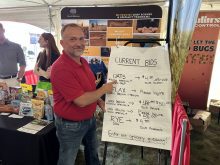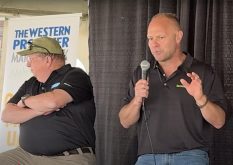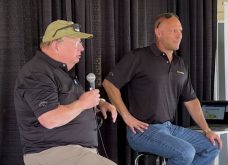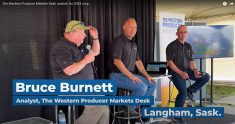SAN ANTONIO, Texas – Scab has become a festering sore for many American wheat growers, worried that the disease will cause buyers to turn to other sources.
“It has had a real impact in my area,” said Mark Gage, a farmer from Page, North Dakota.
Crop damage caused by scab, also known as fusarium head blight, forced him to stop planting durum and malting barley and may eliminate wheat from his rotations.
As importers implement stricter vomitoxin tolerance limits, farmers like Gage have few options for marketing their scab-contaminated wheat.
Read Also

One Beer Market Updates Day 3 – Lentils and beef
Day 3 of the One Beer Market Update at Ag in Motion 2025.
“About the only new use I’ve heard for wheat like that would be kitty litter and I’m not looking forward to an economic future for wheat based on kitty litter,” said Gage, past-president of the National Association of Wheat Growers, during the recent North American Grain Congress in San Antonio.
David Van Sanford, co-chair of the Wheat and Barley Scab Initiative, said fusarium used to be considered a yield-limiting disease but deoxynivalentol or DON levels have increasingly become the more worrisome aspect of the pathogen.
High DON levels indicate the presence of an undesirable toxin. There is also a correlation with decreased gluten strength, he told growers at the congress.
“That is the kind of thing that can kill us,” he warned.
It could drive customers away from North American wheat toward Australia, whose climate protects its wheat from scab.
The economic impact of fusarium can be huge. It cost North Dakota growers an estimated $163 million US last year due to deep price discounts associated with high vomitoxin levels.
“I think we really need to shift our attention now to focus more on DON and find out if there is a gene that actually reduces DON accumulation,” said Van Sanford.
Major importers including Japan and the European Union are tightening regulations governing vomitoxin levels, with the EU considering dropping permissible DON levels in wheat products to as low as 0.1 parts per million.
Despite spending $32 million on the national scab initiative between 1999 and 2005, the United States has not made enough progress in fighting the disease, Van Sanford told his audience.
“The thing is that in a very heavy epidemic, none of them has the level of resistance that we really need,” he said of new varieties.
He said the industry cannot afford to ignore the strides Syngenta has made with its fusarium tolerant transgenic wheat.
“We’ve heard that their material looks good,” said Van Sanford.
Neal Fisher, administrator of the North Dakota Wheat Commission, said Syngenta’s crop could be the first GM wheat that finally offers tangible benefits to both producers and consumers.
“Any reduction in fusarium infection appears to also improve the end product quality, the mill yield, absorption and things like that, which are so important in producing high quality bread products.”
That is compelling evidence for the wheat industry to embrace GM crops, said Fisher.
Van Sanford is also excited by the prospect of Syngenta’s new trait.
“If Syngenta has something good, that would be wonderful,” he said.
That won’t lessen the need to develop other forms of resistance as the disease could mutate over time and overcome Syngenta’s defences, he said.

















